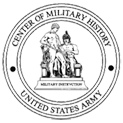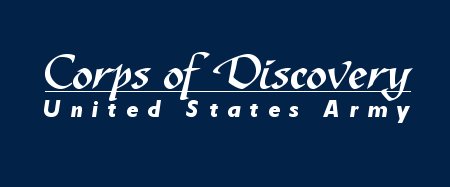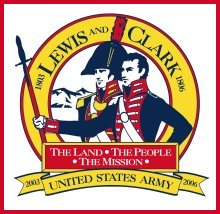Lewis and Clark: Misperception and Reality
by
Charles E. White
Every epic has its accompanying mythology, and “The Corps of Volunteers for North Western Discovery;” more commonly known as “The Lewis and Clark Expedition,” is certainly no exception. Over the past two hundred years, a number of misconceptions about the Expedition and its members have distorted our understanding of this awe-inspiring journey. As we commemorate the bicentennial of the Lewis and Clark Expedition, it’s time to correct three of these popular but mistaken beliefs.
Without question, the most prevalent misconception regarding the Corps of Discovery is the role Native Americans played in the success of the Lewis and Clark Expedition. In 1893, Frederick Jackson Turner presented his famous “Frontier Thesis” at the Chicago World’s Fair.[1] For nearly a century, this influential essay shaped the way in which Americans viewed the frontier, and still enjoys the acceptance of large numbers of ordinary Americans even today. Turner entitled his paper, “The Significance of the Frontier in American History.” In it Turner maintained that Americans won the West. He dismissed Native Americans, the French, British, Dutch, Spanish, Russian, and oriental influences altogether. In Turner’s mind, these people played no role whatsoever in the colonization of the Great West. Indeed, they usually acted as impediments to American efforts to inhabit and civilize the frontier.
Contrary to what Turner maintains, if not for the generosity and hospitality of Native Americans – the Sioux, the Arikara, the Mandan, the Hidatsa, the Shoshone, the Nez Perce, the Chinook, and the Clatsop – America today would probably not be commemorating the 200th anniversary of the Corps of Discovery. Native Americans formed a chain of friendship and support that enabled the Lewis and Clark Expedition to complete its mission successfully. For example, the Teton Sioux could have easily annihilated the Expedition during a confrontation on September 28, 1804, but cooler heads within the tribe averted tragedy. The Mandan and Hidatsa helped the Corps of Discovery through its first winter. The Shoshone provided the horses the soldiers needed to traverse the Rockies, while the Nez Perce saved the men from starvation after their grueling passage over the Bitterroot Mountains. After nearly two centuries of neglect, we are only now beginning to see the Lewis and Clark Expedition from a Native American perspective. Hopefully, this commemoration will also clarify our understanding about the role of Native Americans in the triumph of the Corps of Discovery.
In addition to distorting our view of Native American involvement in the success of the Lewis and Clark Expedition, Turner’s “Frontier Thesis” created the notion that the men of the Corps of Discovery were rugged individualists, clad in buckskins and coonskin caps, and backpacking through uncharted wilderness. Almost every piece of artwork, whether it’s an ink sketch or oil on canvas, depicts the Expedition members dressed in clothing more befitting of “mountain men” than soldiers. Nothing could be further from the truth.
The Lewis and Clark Expedition was a military operation from start to finish.[2] It was no accident that President Thomas Jefferson turned to the Army for this mostimportant mission. Jefferson knew of at least two civilian, commercial explorations of the Missouri valley, and they had failed. Only soldiers possessed the toughness, the teamwork, the discipline, and the training appropriate to the rigors they would face. The United States Army also had a nationwide organization, even in 1803, and thus the potential to provide requisite operational and logistical support. The Army also embodied the American government in a way that civilians could not.
Of the 50 men who traveled up the Missouri River to the Mandan villages in 1804, 36 were soldiers and 12 were contract boatmen. The two other men were York (Clark’s servant) and Drouillard, the interpreter. Of the 33 individuals who made the trip to the Pacific coast in 1805, 28 were soldiers. The other five were York, Drouillard, and the Charbonneau family (Toussiant, Sacagawea, and their newborn son Jean Baptiste). Of the 35 enlisted men, 17 had been in the Army prior to joining the Corps of Discovery, and wore the uniforms of their regiments (the 1st Infantry, the 2d Infantry, and the Regiment of Artillery).[3] Since they had been issued new uniforms every year of their five-year enlistments, these men probably had more than one complete set of clothing to wear on the journey. Eighteen of the men were new recruits who probably did not have all of their issue clothing. None of the enlisted men had any civilian clothing; for according to Army regulations, all civilian clothing was sold or destroyed upon enlistment. [4] During the first winter Camp River Dubois, Captain Clark molded these soldiers into an effective uniformed, military unit.
As the expedition traveled to and from the Pacific Ocean, its journalists left clues in their accounts about what the men wore and when they wore it. Military uniforms – not buckskins – were worn throughout much of the journey. Full-dress uniform coats of red, white, and blue for the regulars, and gray and blue for the new recruits, would have been worn on special occasions. These included military inspections (like the one held on May 27, 1804, and throughout the winter at Camp River Dubois); ceremonies with the Indian tribes (like the council of August 3, 1804); and formal occasions (such as court-martials, punishments, and the August 20, 1804, burial of Sergeant Charles Floyd). Fatigue uniforms of plain, loose-fitting, linen trousers and a Russian-sheeting (hemp cloth) frock were worn most of the time the men were on the boats and in their encampments.
The Journals also indicate that some of the men – most likely the 18 recruits – were beginning to fashion clothing from animal skins during the summer of 1805, when their initial issue wore out. It appears that these men may have been wearing a smattering of leather clothing mixed in with their trail-worn cloth items. On June 10, 1805, Lewis had the men cache some of their clothing and all their superfluous baggage. This cache was unearthed on July 28, 1806, during the return trip.
As their linen and cloth items wore out, the men replaced them with items made of skins. Certainly Sacagawea and other Shoshone women would have been very useful in assisting with the construction of Indian-style clothing, guiding the men in learning the patterns, cutting out the pieces, and putting them together. For this reason what leather clothing of the Expedition may have worn may have been heavily influenced by Shoshone and Mandan-Hidatsa styles.
Throughout the winter of 1805/06, the rain rotted their leather clothing seemingly as fast as the men could make replacements. Lewis lamented on November 24, 1805, that his men had few cloth garments left. By now practiced at making Indian-style clothing, the soldiers of the party knew just what kind of game they were looking for, and what types of skins these animals would yield. During the return trip, little time was expended on the manufacture of new clothing, while the old continued to wear out. Indeed, as the men neared Euro-American settlements on the lower Missouri River, they bartered with the fur traders traveling upriver for familiar woven clothing. On September 6, 1806, Sergeant Ordway reported that he traded with a St. Louis family “for a hat and Shirt by giving them beaver Skins.” By the time the soldiers reached Fort Bellefontaine, just north of St. Louis, the men of the Expedition returned to “civilization” wearing a mixture of the new linen or flannel shirts they had acquired from the traders, breech clouts, and leather. It may have been a sign of how badly they missed the life they had left behind – or just pure comfort – that they were so eager to divest themselves of the buckskin clothing they made for themselves on the frontier.
From the journals it also appears that the officers – Lewis and Clark – may have brought a good deal of clothing along with them, certainly far more than the common soldiers and volunteers were allowed. Evidence in the journals suggests that Lewis had several pairs of breeches, shirts, and coats with him, of varying grades of material. The journals also seem to suggest that neither Lewis nor Clark wore buckskins. Every journal entry regarding clothing always indicates that “the men” – not the officers – are fashioning clothes from leather. Additionally, the soldiers of the expedition shaved on a regular basis (three times a week) and kept their hair closely cropped, in accordance with Army regulations and civilian styles of the times.[5] It simply was not fashionable in the early 1800s for “gentlemen” to dress in leather or to sport beards. Men in buckskins and beards were usually society’s outcasts.
If the journal evidence indicates that military uniforms were worn throughout much of the expedition, and leather clothing was made as required, why do we continually see artwork depicting Lewis and Clark clad in buckskins and coonskin caps? The answer may lie in our society’s commonly held notions of individuality.
Returning to Frederick Jackson Turner’s “Frontier Thesis,” leading the pantheon of heroes who conquered the West was the rugged frontiersman – clad in buckskins and a coonskin cap – whose life epitomized the freedom and individualism that have become traditional American values. “Stand at the Cumberland Gap, “ Turner invited his readers, “and watch the procession of civilization marching single file” behind these rugged individualists. The fact that this procession of civilization encroached on Indian land in violation of every treaty the United States made with the Indian nations did not concern Turner, who dismissed Native Americans as “savages” and asserted that white settlers were merely moving onto “free land.” The work of illustrators such as Charley Russell and Frederick Remington gave a visual imprimatur to Turner’s theme. Later artists and filmmakers followed the example of Russell and Remington. And so today, we continue to see the Corps of Discovery clad in buckskins, wearing coonskin caps, and acting like mountain men, even though the artwork in the journal of Sergeant Patrick Gass (published in 1810), clearly shows the men always dressed as soldiers in uniforms.
The third and final misconception I want to address is the military nature of the Expedition. Every soldier and civilian of the Corps of Discovery was subject to military law and discipline. This certainly runs counter to the popular concept of the rugged individualist, but is clearly crucial to the success of the Expedition. Without strict discipline, the Corps of Discovery would have collapsed like so many other expeditions before and after Lewis and Clark. In their Detachment Order of May 26, 1804, signed jointly by Captains Lewis and Clark, the two officers instituted a daily military routine, making it clear to the men that they were part of a military expedition moving into potentially hostile territory. The two captains refined the military organization they had created at Camp River Dubois, establishing five messes (or squads): three aboard the keelboat, and the remaining two aboard the two pirogues. A noncommissioned officer led each mess, with one exception – the civilian boatmen who formed the fifth mess.
Captains Lewis and Clark commanded the Expedition through the three sergeants – Ordway, Pryor, and Floyd. One sergeant always manned the keelboat’s helm, while another supervised the crew amidships, and the third kept lookout at the bow. The senior sergeant was Ordway, who acted as the Expedition’s first sergeant. He issued daily provisions after camp was set up in the evening. Rations were cooked and a portion kept for consumption the next day. No cooking was permitted during the day. Sergeant Ordway also appointed guard and other details. The guard detail consisted of one sergeant, six privates, and one or more civilians – fully one third of the entire party. The guard detail established security upon landing and maintained readiness throughout the encampment. What we know of military protocol and the characters of Lewis and Clark makes it clear that the Corps of Discovery was a military expedition where discipline, uniformity, and personal appearance mattered.
Perhaps no other episode in American history better represents the courage, determination, and dedication of the American soldier than the epic journey of the Corps of Discovery. The United States Army made a singular contribution to the success of the Lewis and Clark Expedition. The Army furnished the organization and much of the manpower, equipment and supplies. The skill, teamwork, and courage of each soldier contributed significantly to overcoming the huge natural obstacles to crossing the continent. And, the generosity and support of Native American tribes, whose political sovereignty and autonomy were potent realities, guaranteed the success of the Lewis and Clark Expedition.
Over the course of two years, four months, and ten days, the Corps of Discovery traveled approximately 7,689 miles and brought back invaluable geographic and scientific data, including 178 new plants and 122 previously unknown species and subspecies of animals. When the soldiers finally returned on September 23, 1806, their journey had already captured the admiration and imagination of the American people. Indeed, over the past two hundred years, the Lewis and Clark Expedition has become an enduring, if somewhat misrepresented, symbol of the American spirit and human achievement.
[1] See Frederick Jackson Turner, “The Significance of the Frontier in American History.” A paper presented at the American Historical Association Annual Conference, 1893.
[2] See Charles E. White and David W. Hogan, Jr., The U.S. Army and the Lewis and Clark Expedition. U.S. Army Center of Military Publication 70-75-1 (2002).
[3] See Charles G. Clarke, The Men of the Lewis and Clark Expedition: A Biographical Roster of the Fifty-One Members and a Composite Diary of Their Activities from all Known Sources, 1970; reprint edition: The Arthur H. Clark Company, Spokane, Washington, 2001. Also see Gary E. Moulton, Editor, The Journals of the Lewis and Clark Expedition, 13 vols. (Lincoln, NE: University of Nebraska Press, 1986-98), 2 (Appendix A: Members of the Expedition):509-29.
[4] See Stephen J. Allie, The Uniforms of the Lewis and Clark Expedition. Ft. Leavenworth, KS: The Frontier Army Museum, 2002.
[5] See Robert J. Moore, Jr., “Neatness Mattered: Hair, Beards, and the Corps of Discovery,” We Proceeded On (November 2002):23-28. |





